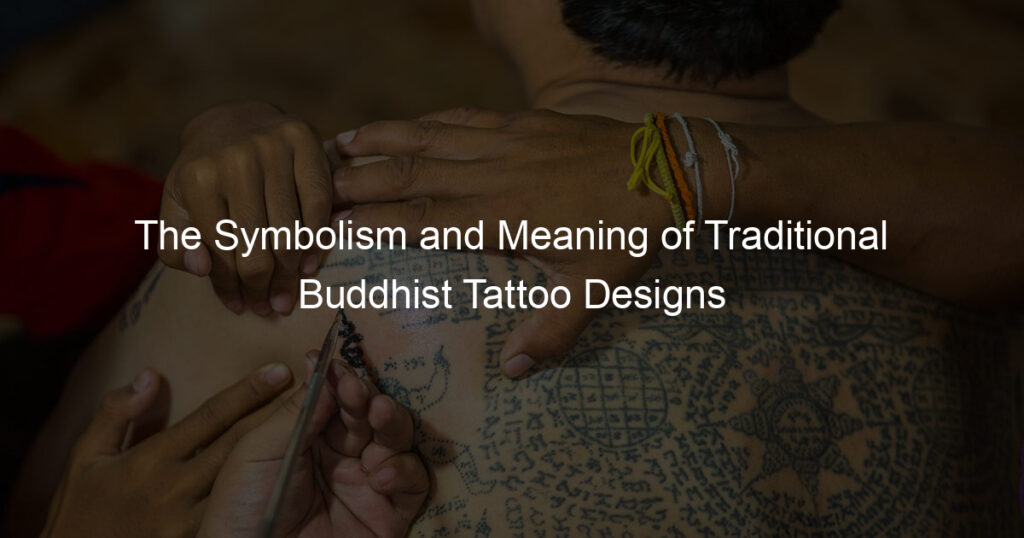When it comes to tattoos, there are endless design possibilities. But for those seeking a tattoo with meaning, traditional Buddhist tattoo designs can be a great option. These tattoos often incorporate symbols and imagery with deep roots in Buddhist culture and history. And while each design has its specific meaning, there is also general symbolism associated with many traditional Buddhist tattoos.
In this post, we’ll explore some of the most popular traditional Buddhist tattoo designs and their meanings. Whether you’re considering a Buddhist tattoo for yourself or are just curious about this fascinating form of body art, read on to learn more!
What does the Buddhist tattoo symbol mean?
For Buddhist followers, tattoos often serve as markers of faith and commitment. The most popular Buddhist tattoo symbol is the Dharma wheel. It symbolizes the teachings of Buddha and how they rotate in motion. The six spokes usually represent the main limbs of Buddhism: the Four Noble Truths, wisdom, morality, and concentration or meditation.
While other symbols might indicate a person’s rank within the faith hierarchy, this symbol simply expresses an appreciation for its teachings and principles that don’t necessarily need to be followed. The Dharma wheel is seen as one of the most accessible symbols of Buddhism for its acceptance by any believer regardless of their level of knowledge of the teachings. Thus, it’s become a source of inspiration to many who aren’t devoutly committed to one particular religion but still find a connection within Buddhist spiritualism.
What are Buddhist tattoos called?
Getting a tattoo is an ancient practice that many cultures have utilized for centuries. Buddhist tattoos are one of the most recognizable of these cultural symbols. Usually, people get Buddhist tattoos to symbolize their connection to Buddhism, or because they are inspired by the core teachings of the faith.
Generally referred to as ‘Buddhist tattoos’, some laypeople also call them Sak Yant tattoos or Yantra tattoos. These striking designs often feature spiritual symbols and traditional elements such as mantras, yantras, and specific animals like tigers, snakes, and garudas. From colorful scenes with monks in prayer to a simple lotus flower with Sanskrit inscriptions, one can find an array of incredibly poetic designs rich with meaning for those interested in Buddhist body art.
What does a Buddha tattoo with a lotus flower mean?
A tattoo of a Buddha with a lotus flower is incredibly significant. Lotus flowers represent strength, purity, and enlightenment – all key concepts in Buddhism. The imagery also reflects personal transformation and new beginnings.
To many people, having this type of tattoo emphasizes the will to rise above struggles and embrace change in life. It’s also a reminder to bring mindfulness into every moment – after all when you look at your arm you’ll see the captivating figure of a sitting Buddha alongside an exquisite lotus flower!
What are Unalome tattoos and their meanings?
Unalome tattoos are a type of spiritual art often worn by Buddhist monks that represent an individual’s journey to enlightenment. They appear as swirls with a line or dot at the end, resembling a path and a destination. The straight line at the end symbolizes reaching Enlightenment, while the winding part of the design can show the life challenges we have to go through to reach Nirvana.
Unalomes can also be adapted to act as symbols for love and protection, for blessing or bringing guidance, or for emotional and physical healing. Therefore, these tattoos can hold powerful personal meaning for each individual who wishes to get them!
What does OM lotus tattoo mean?
An OM Lotus tattoo is a powerful symbol of harmony and balance. This beautiful artwork has a deep spiritual meaning, originating from Hinduism and Buddhism. Drawing attention to the third eye chakra, it emphasizes the importance of connecting one’s mind to their body and spirit in unity.
The lotus combines with the mantra symbol to represent eternal life, offering wearers an opportunity to connect with cosmic energies and remind themselves of their highest potential as spiritual beings. It’s a timeless tattoo that speaks to many different beliefs and ways of life, reminding us all how truly interconnected we are in this grand universe.
Conclusion: The Symbolism and Meaning of Traditional Buddhist Tattoo Designs
After exploring the varied symbolism, deep messages, and meanings behind popular Buddhist tattoos, we can conclude that traditional designs are steeped in history and spiritual depth. From lotus flowers signifying rebirth to Aum symbols representing the unity of mind and body, the combinations of symbols used for these tattoos are innumerable.
Whether you’re looking for a visual representation of your faith or simply want to honor an ancestor from centuries past, traditional Buddhist tattoo designs might be the route to go. These tattoos provide an excellent way to display devotion while offering endless self-expression. Ultimately, every person carries their own story within them, so why not display it proudly? These small pieces of art have the power to ignite inspiration and awaken creativity throughout our lives.














